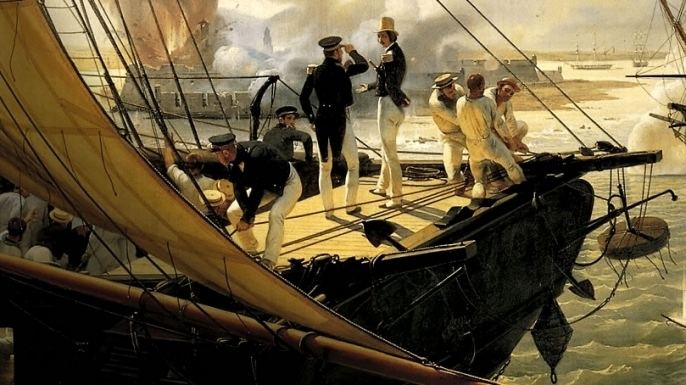3,000 3,239 Dates 27 Nov 1838 – 9 Mar 1839 | 32 dead60 wounded 95 dead129 wounded | |
 | ||
Similar French intervention in Mexico, Reform War, Texas Revolution, Mexican–American War, Mexican War of Independence | ||
wars the pastry war every 5 days
The Pastry War (Spanish: Guerra de los pasteles, French: Guerre des Pâtisseries), also known as the First French intervention in Mexico or the First Franco-Mexican War (1838–1839), began in November 1838 with the naval blockade of some Mexican ports and the capture of the fortress of San Juan de Ulúa in Veracruz by French forces sent by King Louis-Philippe. It ended several months later in March 1839 with a British-brokered peace. The intervention followed many claims by French nationals of losses due to unrest in Mexico.
Contents
- wars the pastry war every 5 days
- 1838 the pastry war
- Background
- Chronology of the conflict
- Peace restored
- References
This incident was the first and lesser of Mexico's two 19th-century wars with France, being followed by the French invasion of 1861–67 which supported the short reign of Emperor Maximilian I of Mexico who was executed by firing squad at the end of said conflict.
1838 the pastry war
Background
During the early years of the new Mexican republic there was widespread civil disorder as factions competed for control of the country. The fighting often resulted in the destruction or looting of private property. Average citizens had few options for claiming compensation as they had no representatives to speak on their behalf. Foreigners whose property was damaged or destroyed by rioters or bandits were usually also unable to obtain compensation from the Mexican government and they began to appeal to their own governments for help and compensation.
Commercial relationships between France and Mexico existed prior to France recognition of Mexico's independence in 1830, and after the establishment of diplomatic relationships France rapidly became Mexico's third largest trade partner. However, France had yet to secure trade agreements similar to those that the United States and England (then Mexico's two largest trade partners) had, and as a result of this French goods were subject to higher taxes .
Chronology of the conflict
In complaint to King Louis-Philippe, a French pastry chef known only as Monsieur Remontel, claimed that in 1832 Mexican officers looted his shop in Tacubaya (then a town on the outskirts of Mexico City). Remontel demanded 60,000 pesos as reparations for the damage (his shop was valued at less than 1,000 pesos).
In view of Remontel's (which gave its name to the ensuing conflict) and of other complaints from French nationals (among them the looting in 1828 French shops at the Parian market and the execution in 1837 of a French citizen accused of piracy) in 1838 prime minister Louis-Mathieu Molé demanded from Mexico the payment of 600,000 pesos (3 million Francs) in damages, an enormous sum for the time, when the typical daily wage in Mexico City was about one peso (8 Mexican reals).
When president Anastasio Bustamante made no payment, the King of France ordered a fleet under Rear Admiral Charles Baudin to declare and carry out a blockade of all Mexican ports on the Atlantic coast from Yucatán to the Rio Grande, to bombard the Mexican fortress of San Juan de Ulúa, and to seize the city of Veracruz, which was the most important port on the Gulf coast. French forces captured Veracruz by December 1838 and Mexico declared war on France.
With trade cut off, the Mexicans began smuggling imports via Corpus Christi, Republic of Texas and into Mexico. Fearing that France would blockade the Republic's ports as well, a battalion of Texan forces began patrolling Corpus Christi Bay to stop Mexican smugglers. One smuggling party abandoned their cargo of about a hundred barrels of flour on the beach at the mouth of the bay, thus giving Flour Bluff its name. The United States, ever watchful of its relations with Mexico, sent the schooner Woodbury to help the French in their blockade
Meanwhile, acting without explicit government authority, Antonio López de Santa Anna, known for his military leadership, came out of retirement from his hacienda near Xalapa and surveyed the defenses of Veracruz. He offered his services to the government, which ordered him to fight the French by any means necessary. He led Mexican forces against the French. In a skirmish with the rear guard of the French, Santa Anna was wounded in the leg by French grapeshot. His leg was amputated and buried with full military honors. Exploiting his wounds with eloquent propaganda, Santa Anna catapulted back to power.
Peace restored
The French forces withdrew on 9 March 1839 after a peace treaty was signed. As part of said treaty the Mexican government agreed to pay 600,000 pesos as damages to French citizens while France received promises for future trade commitments in place of war indemnities. However, this amount was never paid and that was later used as one of the justifications for the second French intervention in Mexico of 1861.
Following the Mexican victory in 1867 and the collapse of the second French empire in 1870, Mexico and France would not resume diplomatic relationships until 1880 when both countries left behind claims related to the wars .
